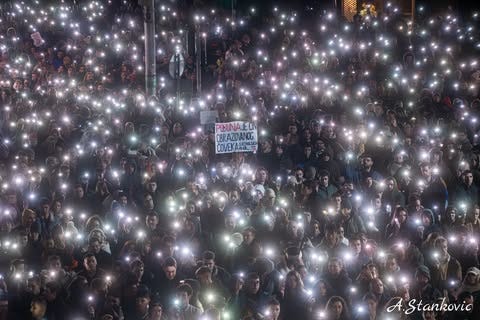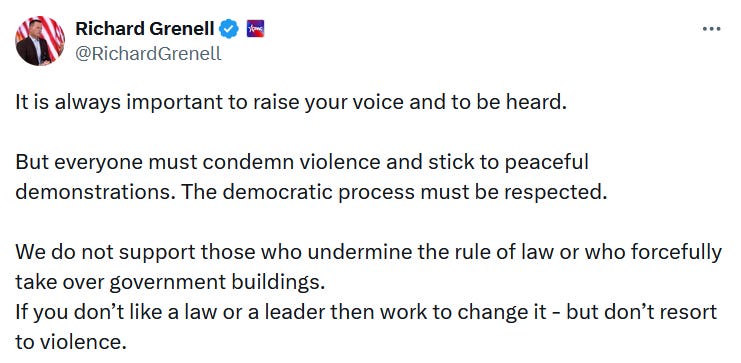SPECIAL ISSUE - The great Serbian blockade
Serbian President Aleksandar Vučić is facing his biggest challenge so far. This special issue is a deep dive into the protests in Serbia: what has happened, what is happening, and what to expect.
Hiya,
Hope you’re doing well and feeling refreshed, ready to tackle the week! Hate to break it to you, but nope, today’s not Friday. It’s Monday, and the whole week is stretched out ahead of us.
It’s been a long, long weekend in Serbia. Protests swept through the capital and several other cities — and there’s no sign they’re slowing down anytime soon.
For nearly three months now, people in Serbia have been out in the streets protesting. We figured this would be the perfect time for a special edition of Balkan Brew: a little recap of what’s happened so far, where things stand now, and what might be next.
BUT FIRST. If you enjoy our newsletter and want to support what we’re doing, why not forward it to someone who might dig it too? And if you’re new here, join us. Just hit that subscribe button — easy as that! 👇
The great Serbian blockade
It’s been a long, long weekend in Serbia. Tens of thousands of people joined students in Belgrade on January 24 to protest against the government. Protests also took place in several other cities, including Novi Sad and Niš. BIRN has a pretty detailed rundown of all the towns where people joined in, and the institutions who did.
IN A NUTSHELL. The protests were peaceful overall, though a student was hit by a car in Belgrade (her condition is stable but still serious). Meanwhile, Serbian police have filed charges against seven opposition politicians who blocked the highway between Novi Sad and Belgrade. Oh, and Serbian President Aleksandar Vučić held a counter-protest in the town of Jagodina (more on that below).
MEET THE STUDENTS. Want to get the scoop straight from the source? Check out the profile Studenti u blokadi on Instagram and X to stay in the loop.
HOW DID WE GET HERE. Protests in Serbia kicked off after the canopy of the Novi Sad railway station collapsed on November 1, killing 15 people. Since then, many in Serbia have taken to the streets — not just to honor the victims, but to demand that authorities release all documents related to the recent renovation of the building and hold any wrongdoers accountable.
RAMPING UP. Students got more involved after one of them was attacked outside the Faculty of Dramatic Arts in Belgrade on November 22. A reporter from the local Nova.rs was also attacked, as shown in the video below.
Dozens of faculties and schools have joined the protests since. Over the past two months, more than 85 of them across the country have been occupied, according to the BBC.
GETTING BIGGER. The protests have spread far and wide (even in small and quite peripheral places). According to the independent Archive of Public Gatherings, demonstrations have been held in at least 100 locations across Serbia since the railway station collapse. And it’s not just locals — protests are happening regularly abroad, too.
WHAT DO STUDENTS WANT? The protesters’ demands include publishing all documentation on the Novi Sad railway station renovation, identifying and prosecuting those responsible for the collapse, and investigating attacks on students during the protests. You can find a full list of their requests here.
MONTHS OF BLOCKADE. Curious about what life looks like inside an occupied faculty? BBC Srbija interviewed Olja Nikolić, a student from the Faculty of Dramatic Arts. Her take: “Somehow, we’ve become a big family.”
WHERE DOES IT HURT? Protesting students have faced violence and attacks. The Center for Investigative Journalism of Serbia has created a map documenting all recorded incidents.
FARMERS TO THE RESCUE. On Saturday, farmers from the Voivodina region joined the protests in Novi Sad to show solidarity with the students. By Sunday, they’d driven their tractors to Belgrade to “protect the students” and announced they’d stay “as long as necessary.”
ALL DOGS GO TO HEAVEN. Shoutout to Dona, Novi Sad protests’ riot dog who was killed during Friday’s demonstrations. Protesters are now honoring her memory as the sixteenth victim of the Novi Sad railway collapse.
Vučić strikes back (kind of)
Observers agree that these protests are the biggest challenge the Serbian Progressive Party (SNS) and its leader, President Aleksandar Vučić, have faced in years. And, so far, the government’s response has not been successful in stopping them.
FIRST ATTEMPTS. Thirteen people were arrested in connection with the Novi Sad incident, including former Minister of Civil Affairs, Transport and Infrastructure Goran Vesić, who has since been released. However, that wasn’t enough for the protesters, who don’t trust that those responsible will face consequences.
STILL NOT ENOUGH. In December, Vučić announced that all 195 documents related to the reconstruction work at the Novi Sad train station had been published, but the protests did not stop. In the meantime, more documents have appeared. On January 26, after referring to the 1003 documents released so far, Vučić urged the publication of all the documents.
BEEN THERE, DONE THAT. This isn’t Vučić’s first time dealing with mass protests. His go-to strategy? Let the protests fizzle out on their own while continuing to win elections (FYI, his party currently holds 112 out of 250 MPs in parliament — here’s the full list).
PIECE OF CAKE. Of course, winning elections is easy — if you know how to do it. For years, SNS has been accused of eroding political rights and civil liberties, silencing independent media, and putting pressure on the opposition and civil society groups.
FINE! I’LL HAVE MY OWN RALLY. On Friday, Vučić and SNS staged their own counter-protest in Jagodina, a town in central Serbia. Vučić used the opportunity to promote his newly launched “Movement for the People and the State” and called for dialogue with students.
WHAT PROTEST? Pro-government media are doing their part to downplay the protests. Don’t believe us? Just take a look at the front pages of Politika, Kurir, and Blic from Saturday morning.
GUESS WHO? #1. Richard Grenell, U.S. President Trump’s “envoy for special missions” (and long-term friend of Vučić) has thrown his criticism at the protesters.
GUESS WHO? #2. Maria Zakharova, the Russian MFA spokesperson, has accused “the West” of being behind the protests.
What now?
It’s quite hard to tell what might be coming next. However, we can at least give you some bits of information about things that you might want to keep an eye on in the next few days.
CONFIDENCE. The President of the Serbian parliament, Ana Brnabić, said that the parliament will have a vote of confidence on the current SNS-led government. The session is scheduled for 29 January.
BY THE WAY. Brnabić is one of the most recognizable SNS politicians, and a long-time loyalist of President Vučić. On Friday she shared a reel boosting the good results obtained by Vučić for the Serbian economy. Enjoy the watch.
NO RETREAT. Meanwhile, all signs point to the fact that protests will go on: today, starting from 10 am, students have announced they will block the traffic in the big looped interchange of the Autokomanda neighborhood in Belgrade, a key traffic infrastructure for the city.
And this is it for today. If you liked this special issue, consider showing us your support by forwarding this newsletter to anyone who might be interested. If you have just received it, why not subscribe? As always, we are happy to hear your feedback: did we miss something? Saw a mistake? Just reply to this email, or reach out to us on Bluesky. This is us: Rodolfo & Tommaso.
We’ll be back on Friday!
Take care,
BB














